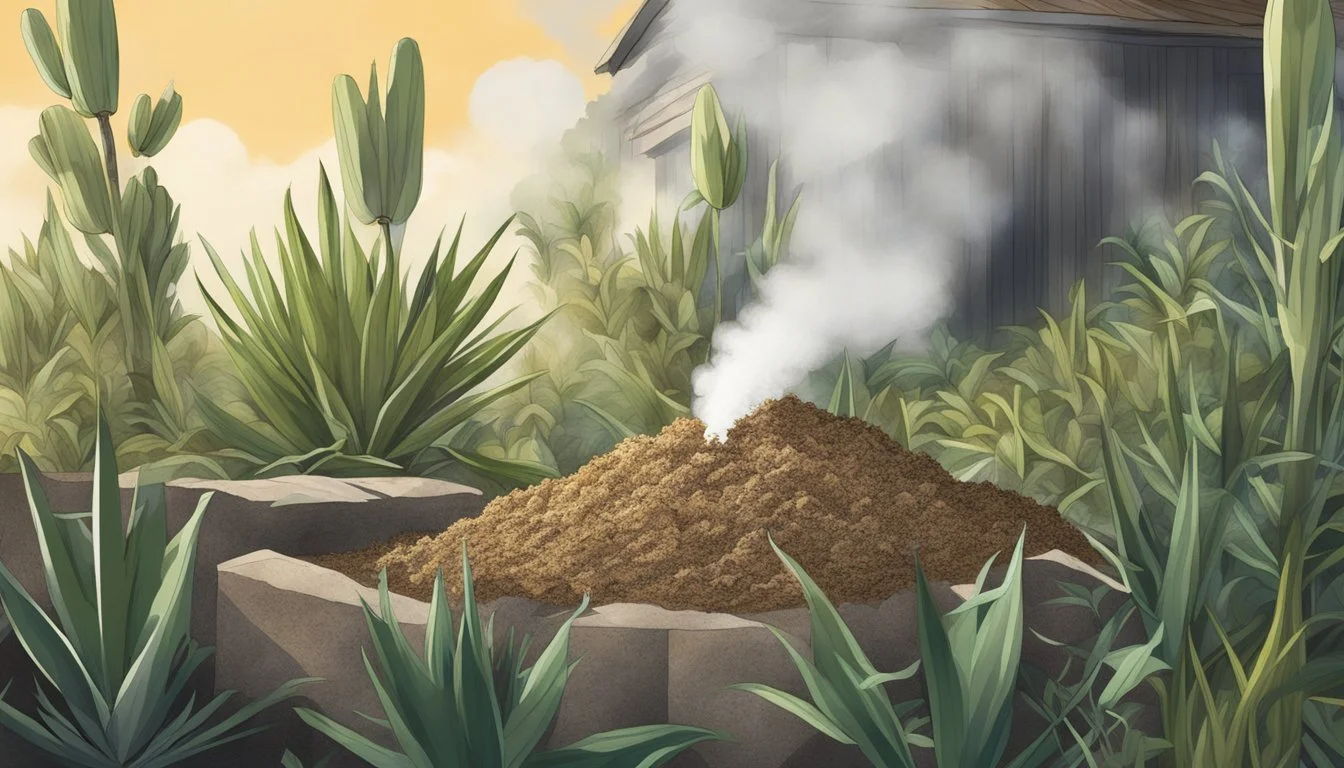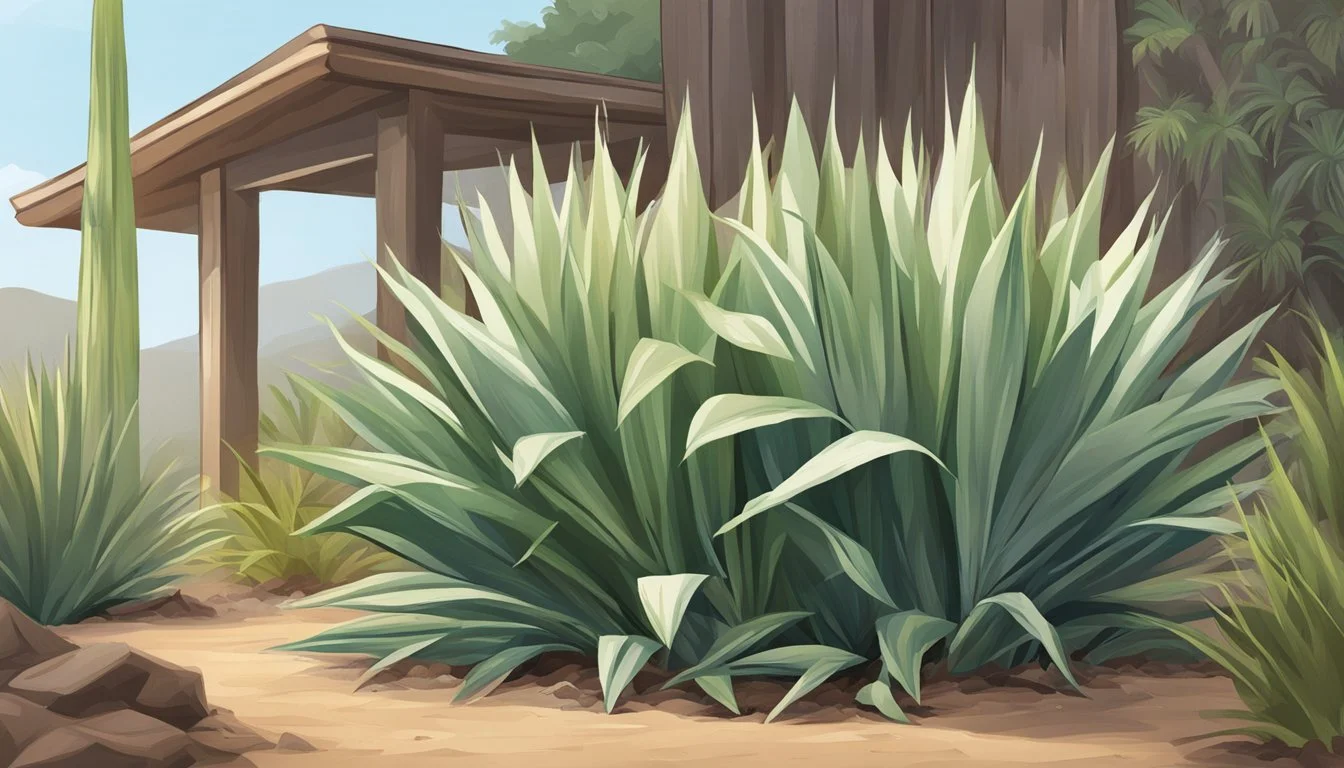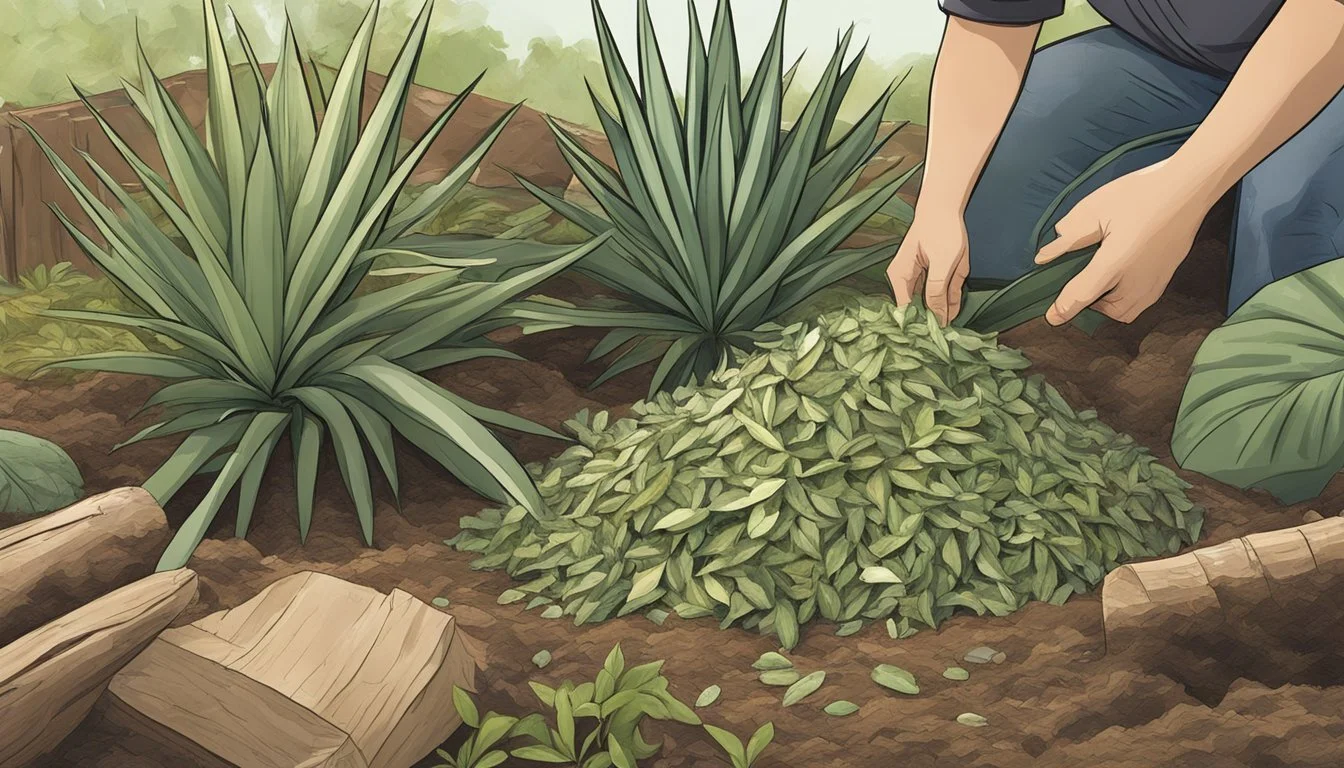Can You Compost Yucca Leaves?
Understanding the Basics of Yucca Composting
Composting yucca leaves can be an excellent way to recycle plant material and turn it into nutrient-rich soil for the garden. Yucca leaves, when broken down in a compost pile, contribute to the creation of a humus-like material that benefits the soil structure and provides nutrients to plants. Yucca plants, often used in landscaping for their hardy nature and appealing appearance, can sometimes outgrow their space or need pruning, providing an ample supply of leaves for composting.
Although all leaves can technically be composted, not all decompose at the same rate or provide the same nutrients to the final compost. Yucca leaves are tough and fibrous, which means they may take longer to break down than softer, more succulent plant materials. To facilitate the composting process, shredding or cutting the yucca leaves into smaller pieces can help quicken their decomposition, integrating them more effectively into the compost pile.
Adding yucca leaves to a compost requires balance with other compostable materials, such as fruit and vegetable scraps or grass clippings, to ensure a proper carbon-to-nitrogen ratio. The result is a versatile compost that can be used to enrich garden soil, contributing to healthier plant growth and a more sustainable gardening practice.
Yucca Plants Overview
Yucca plants are recognized for their ease of growth, both in landscapes and as indoor plants. They consist of over 40 species, with some like Yucca elephantipes being particularly popular for their hardy nature and aesthetic appeal.
Yucca Species and Varieties
Yucca is a genus comprising a wide variety of species, which include perennials, shrubs, and trees. Significant varieties such as spineless yucca (Yucca elephantipes), native to Central America, are well-suited as both houseplants and landscape features. Here are a few examples:
Yucca aloifolia: Known for its sharp, sword-like leaves.
Yucca gigantea (Yucca elephantipes/Y. guatemalensis): A large, spineless species often used as a focal point in both indoor and outdoor settings.
Growth Requirements
Yuccas require a few specific conditions for optimal growth:
Light: They prefer bright, indirect sunlight but can tolerate direct sun.
Temperature: These plants thrive in warmer climates, with a preference to stay above 7°C.
Soil: A soil-based compost augmented with horticultural sand or grit ensures good drainage, which is crucial for preventing root rot.
Yucca in Landscaping
Yuccas are a popular choice in landscaping due to their hardy and drought-tolerant nature, making them especially suited for arid and semi-arid regions. As focal points, yuccas provide a striking architectural element to the garden. Their rosettes of leaves at the end of woody stems add texture and form to the landscape, embodying both function and aesthetics.
Fundamentals of Composting
Composting is a biological process in which microorganisms decompose organic matter, turning it into a nutrient-rich soil amendment. This section covers the mechanics behind composting and the optimal conditions required for successful decomposition.
Composting Process Explained
Composting involves the breakdown of organic matter by microbial activity. The process transforms waste such as leaves, vegetable scraps, and yard trimmings into compost, which is a stable material rich in nutrients. These nutrients are beneficial to soil health and plant growth.
Key Components of Composting:
Organic Matter: The base of any composting effort; can include leaves, plant residues, fruit scraps, and other biodegradable materials.
Moisture: Essential for the survival of composting microbes; the pile should be moist but not waterlogged.
Temperature: A warm temperature enhances microbial activity. A compost pile should ideally be between 135°F and 160°F to expedite the decomposition process.
Nitrogen Levels: Necessary to support the growth of microbes. Materials high in nitrogen, such as green plant waste, help maintain proper nitrogen levels.
Microbes: The invisible workforce; they drive the decomposition process by breaking down organic materials into humus.
The decomposition results in a dark, crumbly substance called compost that greatly enhances soil quality by improving structure and water retention.
Optimal Conditions for Composting
To create compost efficiently, certain environmental conditions must be met. These conditions help maintain an active and healthy microbial population within the compost pile.
Ideal Conditions:
A Balanced Ratio of Carbon to Nitrogen (C): A C ratio of approximately 25-30:1 is optimal for microbial activity.
Adequate Aeration: Regular turning of the compost pile introduces oxygen, which is vital for aerobic decomposition.
Consistent Moisture Levels: The pile should have the wetness of a wrung-out sponge, a level that helps microbes thrive without drowning them.
Proper Pile Size: A composting pile should be at least 3 feet in height and width to retain heat but not so large that it becomes anaerobic in the center.
By maintaining these conditions, composters encourage a faster and more effective composting process. The end result is a rich humus filled with nutrients that not only feeds plants but also improves soil structure and water retention.
Composting Yucca Leaves
Yucca plants can be a valuable addition to compost, offering nutrients and organic material beneficial for garden soils. Each subsection explores the merits and considerations for including yucca leaves in a composting strategy.
Benefits of Yucca Leaves in Compost
Nutrient Contribution: Yucca leaves are rich in necessary nutrients that can enrich compost. They release nitrogen, potassium, and phosphorus, which are essential for healthy plant growth. The robust nature of yucca leaves also means that as they break down, they can help to aerate the compost, providing better oxygenation for the microorganisms at work.
Organic Material Increase: Yucca leaves, when added to the compost, contribute to the organic matter content. This improves the soil’s water retention and structure when the finished compost is used as a mulch or soil amendment.
Challenges with Yucca Leaves Decomposition
Toughness of Leaves: Due to the high lignin content, yucca leaves can take longer to decompose than other plant materials. Their tough texture means they need more time to break down into humus, the rich organic component of soil.
Size and Shape: The leaves' size and shape may create challenges in composting them effectively. They can mat together, forming layers that resist water and limit airflow, which can slow the decomposition process.
Preparation of Yucca Leaves for Composting
Shredding: To expedite their decomposition, yucca leaves should be shredded into smaller pieces. This increases the surface area for microbes to work on and helps to prevent the leaves from matting together.
Layering: When adding shredded yucca leaves to compost, they should be layered with other green and brown materials. This ensures a balanced mix of carbon and nitrogen, which is vital for efficient composting. Layers of yucca should alternate with layers of materials like vegetable scraps or grass clippings to avoid compaction and to maintain a balanced compost.
Incorporating yucca leaves into a composting system can be beneficial but requires some preparation to ensure they decompose effectively. Careful shredding and mindful layering are key steps to successfully composting yucca leaves.
Composting Other Garden and Kitchen Waste
Effective composting of garden and kitchen waste not only enriches soil but also reduces environmental waste. It's crucial to understand the specifics of composting different materials such as grass clippings, fruit and vegetable scraps, and particular garden wastes like wood chips or pine needles.
Composting Grass Clippings and Tree Leaves
Grass clippings add nitrogen to the compost pile, which is essential for composting. They should be composted in thin layers to prevent matting, which can slow decomposition. Tree leaves, especially those from fruit trees, are rich in minerals and break down well, making them excellent for composting. However, one should be cautious with leaves from trees like oak or those high in lignin, which can take longer to decompose.
Grass Clippings: Add in thin layers
Fruit Tree Leaves: High in minerals, compost well
Oak Leaves/Pine Needles: Decompose slowly; use sparingly
Composting Fruit and Vegetable Scraps
Fruit and vegetable scraps from the kitchen are ideal for composting, significantly enhancing the nutrient content of the resulting compost. It's important to bury these scraps in the compost pile to deter pests and to encourage even breakdown.
Fruit Scraps: Include peels, cores, and spoiled fruit
Kitchen Scraps: Bury within compost to avoid pests
Vegetable Gardens: Compost plant remains at season's end
Considerations for Composting Specific Materials
When composting yard waste or specific materials, one must consider the carbon-to-nitrogen ratio, moisture content, and size of the materials for efficient decomposition. For example, wood chips can be high in carbon and take longer to break down, so they should be used in moderation and mixed with nitrogen-rich materials.
Wood Chips: High carbon, decompose slowly
Yard Waste: Balance with kitchen waste for better compost
Fallen Leaves: Shred to speed up decomposition
By understanding and applying these specifics, one can compost various garden and kitchen wastes effectively, ultimately contributing to a healthier garden and a more sustainable environment.
Compost Use and Soil Health
Integrating compost, such as that derived from yucca leaves, into garden practices can significantly enhance soil nutrient content, improve soil structure, and bolster plant growth.
Using Compost as Fertilizer
Compost acts as a gentle, slow-releasing fertilizer, providing nutrients to garden soil over time. Yucca compost contributes vital elements like nitrogen, potassium, and phosphorus—key components that plants need to thrive. Applying this fertilizer ensures a gradual nourishment flow, which is less likely to cause nutrient run-off or plant burn compared to synthetic alternatives.
Improving Soil Structure with Compost
The addition of compost to soil works remarkably well as a soil amendment. It introduces organic matter which improves the soil structure by enhancing its ability to retain moisture and nutrients. For clay soils, compost aids in creating a crumb structure that improves drainage and aeration. For sandy soils, it increases water retention, making beneficial watering practices more effective.
Effects of Compost on Plant Health and Growth
Compost not only contributes to fertilize but also impacts overall plant health. By improving soil structure, roots have better access to air, water, and nutrients. For trees and plants, this results in healthier growth patterns and increased resilience against pests and disease. The presence of microorganisms and essential nutrients in compost directly correlates with vibrant and productive gardens.
Precautions and Additional Tips
When composting yucca leaves, it's crucial to consider the plant's properties and the composting environment. Certain precautions are needed to handle potentially toxic or acidic plant materials, and additional steps may be required to balance the compost pH when incorporating ash or to adapt composting practices to different climates.
Handling Toxic and Acidic Plant Materials
Toxicity: Yucca leaves are not considered toxic, but caution should be taken if composting plants like yucca that could have mildly toxic components, particularly in large quantities. Ensure any toxic plants are not accessible to children or pets when adding them to the compost.
Juglone Sensitivity: Avoid composting leaves from black walnut trees, as they contain juglone, a compound harmful to many plants. Yucca plants do not produce juglone, but being aware of its effects is important when composting a variety of garden waste.
Acidic Materials: Acidic plant materials can be composted effectively by balancing them with more alkaline substances. Occasional checking of the compost's pH is recommended to maintain a neutral environment that aids decomposition.
Incorporating Ash and Other Alkaline Substances
Ash: Wood ash can be added to the compost in small amounts as it is alkaline and provides calcium. It can help neutralize acidic materials in your compost but should be used sparingly to avoid increasing the pH too much.
Balance: To maintain a balanced compost pile, gardeners should aim for a mix that includes 'greens' (nitrogen-rich materials) and 'browns' (carbon-rich materials) in the correct ratios, which often falls around 1 part greens to 25-30 parts browns.
Composting in Different Climates
Temperature: In hot climates, yucca leaves will decompose more quickly; moisture levels must be monitored closely to prevent the compost from drying out.
Hot Climates: A misting system might be helpful to maintain appropriate moisture levels without over-saturating the pile.
Autumn Composting: In cooler autumn temperatures, decomposition will slow down, requiring more attention to ensuring adequate insulation and aeration to sustain microbial activity within the compost pile.
Advanced Composting Techniques
Efficient composting of yucca leaves requires sophisticated strategies to enhance decomposition and enrich the compost with essential nutrients.
Layering and Aeration Strategies
In composting, the layering approach is crucial for balancing green and brown materials, which should be done in a way that optimizes microbial activity. For yucca leaves, which are relatively soft and may hold more moisture than other greens, it's important to layer with brown materials like straw or wood ash to prevent matting and to improve air flow. Alternating layers of yucca leaves with these brown materials creates air pockets that help microbes thrive.
Green Materials (Nitrogen-rich): Yucca leaves, vegetable scraps
Brown Materials (Carbon-rich): Straw, wood ash, sawdust
Proper aeration is another key factor in successful composting and can be accomplished by turning the pile regularly. This introduces oxygen that is crucial for aerobic decomposition, speeding up the breakdown process.
Speeding Up the Composting Process
Increasing the surface area of compost materials by shredding can significantly hasten decomposition. Yucca leaves should be shredded or chopped into smaller pieces before adding them to the compost pile. Enhancing aeration and maintaining adequate moisture levels are also essential to create an ideal environment for microbes to function efficiently. Incorporating nitrogen sources, like coffee grounds or flour, can accelerate the activity of decomposing bacteria.
Shred material: Cut yucca leaves into smaller pieces
Aerate: Turn compost pile regularly
Moisture and Temperature: Keep moist and warm to support microbe activity
Utilizing Compost Activators and Enzymes
Compost activators can be used to supply a concentrated dose of microbes and enzymes required for breaking down tough plant materials. They typically contain nitrogen, phosphorus, and potassium, which help nurture the microbial population. Materials like flour or rice bran can serve as natural activators that introduce starches and proteins to feed the microbes.
Natural Activators: Flour, rice bran
Compost Enzymes: Products designed to break down complex plant fibers
While yucca leaves are not a typical cactus, their fibrous nature can be likened to that of soft cactus leaves which are also compostable. The right balance of green and brown materials, regular aeration, and employing compost activators will lead to a successful and nutrient-rich composting result.
Frequently Asked Questions
This section addresses common queries regarding composting yucca, managing pests within compost, and utilizing finished compost effectively.
Can You Compost Yucca Pups and Offsets?
Yes, one can compost yucca pups and offsets. When yucca plants are repotted or propagated, the pups and offsets can be broken down into mulch, providing nutrients as they decompose. This process not only recycles plant material but also enriches the soil with organic matter.
How to Manage Pests in Compost?
To manage pests such as mealybugs and diseases that can proliferate in compost piles, one should regularly turn the compost to disrupt pest life cycles. It's also advisable to maintain a balanced compost by adding a mixture of green and brown materials and ensuring proper aeration to prevent conditions that favor pest growth.
Common Pests Include:
Leaf spot: Prevent by ensuring good air circulation.
Mealybugs: Remove manually or use natural predators if found on plant debris.
Best Practices for Storing and Using Finished Compost
Finished compost should be stored in a dry, covered area to prevent nutrient loss and the introduction of seeds from invasive species. Before using the compost as mulch or incorporating it into garden soil, one should ensure it is fully decomposed to avoid the spread of diseases or pests from partially decomposed material.
Best Practices:
Storage: Keep the compost pile covered.
Usage: Use the mature compost within a year for the best nutrient profile.








